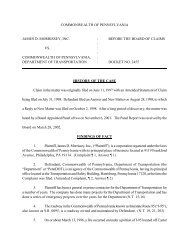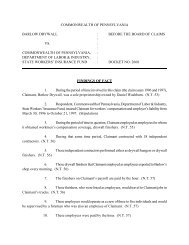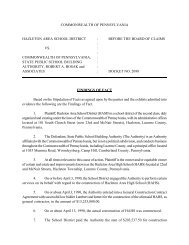3720 - Board of Claims
3720 - Board of Claims
3720 - Board of Claims
You also want an ePaper? Increase the reach of your titles
YUMPU automatically turns print PDFs into web optimized ePapers that Google loves.
January 2002 meeting that GPU was having trouble with a local landowner acquiring permission<br />
to anchor its guy wires on this individual’s property.<br />
Based on the evidence as a whole, the <strong>Board</strong> finds that PennDOT failed to adequately<br />
perform its pre-Contract utilities coordination responsibilities. To begin with, we note our<br />
agreement with Intercounty's general proposition that the “coordinated” approach to relocating<br />
the utility poles on this Project called for careful and effective planning and design on<br />
PennDOT's part prior to the Contract being awarded. We further agree that PennDOT's failure to<br />
convey to the Utilities the detailed Construction Sequence by which the Project was to be built<br />
prevented the Utilities from developing a cogent work plan and schedule for relocating the utility<br />
poles to coincide with Intercounty’s scheduled work prior to the pre-job conference held<br />
immediately before the commencement <strong>of</strong> work. 9<br />
Additionally, we find that the failure <strong>of</strong><br />
PennDOT's design team to identify on the Project's final plans and drawings which poles were to<br />
be relocated and the locations <strong>of</strong> the new poles to be installed further hindered the Utilities’<br />
planning; exemplified the lack <strong>of</strong> sufficient coordination in this early phase; and contributed to<br />
the pole relocation problems experienced on site during the construction phase. Most<br />
significantly, however, we find that PennDOT's failure to provide final plans and drawings<br />
affording adequate space for guy wires within PennDOT's right-<strong>of</strong>-way for all the new poles was<br />
a material defect in its design, responsible for substantial delay in utility pole relocation. 10<br />
9 Mr. Pilosi admits he did not send the Construction Sequence to the Utilities to provide them advance notice <strong>of</strong> the<br />
upcoming Project work plan. Since the Construction Sequence was set forth in the final plans and drawings for the<br />
Project, it is apparent that he also failed to provide to the Utilities with the Project’s final plans and drawings in<br />
advance <strong>of</strong> the job meetings. The evidence presented (including Mr. Pilosi's testimony) is less clear on whether he<br />
ever told the Utilities when the Project was expected to start prior to the May 23, 2001 contract award letter so the<br />
relocation work would be put in the Utilities' work queue in a reasonably timely manner.<br />
10 Even though the guy wire problem pertains to only a few poles, we note that the inability to properly place even a<br />
few new poles among those to be relocated (while not preventing installation <strong>of</strong> all new poles) would nonetheless<br />
preclude moving/restringing the utility lines themselves and, therefore, would delay removal <strong>of</strong> the old poles (which<br />
were the actual physical impediment to Intercounty's excavation and paving work) until the guy wire problems and<br />
new pole placements were finally resolved.<br />
70






